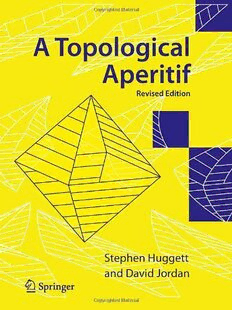
A Topological Aperitif PDF
Preview A Topological Aperitif
A Topological Aperitif Revised Edition Stephen Huggett David Jordan · A Topological Aperitif Revised Edition 123 StephenHuggett DavidJordan Plymouth,UK Hull,UK ToAnneandDinh ISBN978-1-84800-912-7 e-ISBN978-1-84800-913-4 DOI10.1007/978-1-84800-913-4 BritishLibraryCataloguinginPublicationData AcataloguerecordforthisbookisavailablefromtheBritishLibrary LibraryofCongressControlNumber:2008937803 MathematicsSubjectClassification(2000):54-01,57-01 (cid:2)c Springer-VerlagLondonLimited2001,2009 Apartfromanyfairdealingforthepurposesofresearchorprivatestudy,orcriticismorreview,aspermitted undertheCopyright,DesignsandPatentsAct1988,thispublicationmayonlybereproduced,storedor transmitted,inanyformorbyanymeans,withthepriorpermissioninwritingofthepublishers,orin thecaseofreprographicreproductioninaccordancewiththetermsoflicensesissuedbytheCopyright LicensingAgency.Enquiriesconcerningreproductionoutsidethosetermsshouldbesenttothepublishers. Theuseofregisterednames,trademarks,etc.,inthispublicationdoesnotimply,evenintheabsenceofa specificstatement,thatsuchnamesareexemptfromtherelevantlawsandregulationsandthereforefreefor generaluse. Thepublishermakesnorepresentation,expressorimplied,withregardtotheaccuracyoftheinformation containedinthisbookandcannotacceptanylegalresponsibilityorliabilityforanyerrorsoromissionsthat maybemade. Illustrations: Figures 4.12–4.14, 5.3–5.7, 5.21, 5.22, D.14, D.15 and D.18 are reproduced by the kind permissionofthePolymorphicConstructionCompanyLtd.(cid:2)c 2000.Allrightsreserved. Printedonacid-freepaper SpringerScience+BusinessMedia springer.com Foreword Topologyhasbeenreferredtoas“rubber-sheetgeometry”.Thenameisapt,for the subject is concerned with properties of an object that would be preserved, no matter how much it is stretched, squashed, or distorted, so long as it is not inanywaytornapartorgluedtogether.One’sfirstreactionmightbethatsuch animprecise-soundingsubjectcouldhardlybepartofseriousmathematics,and wouldbeunlikelytohaveapplicationsbeyondtheamusementofsimpleparlour games. This reaction could hardly be further from the truth. Topology is one of the most important and broad-ranging disciplines of modern mathematics. It is a subject of great precision and of breadth of development. It has vastly many applications, some of great importance, ranging from particle physics to cosmology, and from hydrodynamics to algebra and number theory. It is also a subject of great beauty and depth. To appreciate something of this,itisnotnecessarytodelveintothemoreobscureaspectsofmathematical formalism. For topology is, at least initially, a very visual subject. Some of its concepts apply to spaces of large numbers of dimensions, and therefore do not easily submit to reasoning that depends upon direct pictorial representation. But even in such cases, important insights can be obtained from the visual pe- rusal of a simple geometrical configuration. Although much modern topology dependsuponfinelytunedabstractalgebraicmachineryofgreatmathematical sophistication, the underlying ideas are often very simple and can be appreci- ated by the examination of properties of elementary-looking drawings. Wefindmanyexamplesofthiskindofthinginthisbook.Thereareagreat many diagrams, carefully chosen so as to bring out, in a directly visual way, most of the basic ingredients of topological theory. It provides a marvellous introduction to the subject, with many different tastes of ideas that can be appreciated by a reader without much in the way of mathematical sophistica- tion. The reader who desires to follow up these fascinating ideas will stand in v vi Foreword an excellent position to pursue the subject further, having mastered the basic techniques that are introduced here. The authors of this work, Stephen Huggett and David Jordan, both have excellent credentials for explaining the beauties of this curiously austere but potentially enormously general form of geometry. Some 20 years ago, Stephen Huggettwasagraduatestudentofmine,andhealwayshadaparticularflairfor conveyingtheexcitementthathehimselffeltforthemagnificenceofgeometrical andtopologicalformsofargument.DavidJordanisknowntomeasthecreator of some beautifully constructed and ingeniously precise geometrical shapes. Both authors are clearly well placed to do the job that they have set out here to do, and in this I believe that they have succeeded excellently. Roger Penrose Mathematical Institute, Oxford Preface Logic merely sanctions the conquests of the intuition. Jacques Hadamard Topology is geometry without distance or angle. The geometrical objects of study, not rigid but rather made of rubber or elastic, are especially stretchy. We want to present mathematics that is mind-stretching and magic, of a style that is conceptual and geometric rather than formulaic. In doing so we hopetowhetthereader’sappetiteforthiswayofthinking,whichisatthesame time very old and very modern. It started with classical Greek geometry and isstillakeypartofcurrentmathematicalresearch,whichisespeciallylivelyin geometry and topology. Indeed, just as in classical Greece, our understanding of the physical universe depends upon this geometrical thinking. The heart of the book is in the first five chapters: homeomorphisms, sur- faces, and polyhedra. Although these ideas are broadly pitched at the level of a second year undergraduate, the authors expect a tenacious mind with much less background to grasp them. The arguments of Chapter 6, still geometri- cal in style, add strength to the earlier chapters. This is not a book of pure geometry, as is Euclid, but rests upon the fine structure of the real number system.Theseunderpinningsaremostlyextractedfromtheearlychaptersand collectedinAppendixA.AppendixBgivesafleetingglimpseintoknottheory, introducing the Jones polynomial. Further breadth is given in Appendix C, in which we sketch the curious and instructive early history of topology. The main ideas are illuminated by a wide variety of geometrical examples that we hope will fascinate and intrigue. Although elementary, the mathemat- ics in this book is sharp and subtle, and will not be properly grasped without vii viii Preface serious attempts at the exercises, the essential challenge of which may be un- done by a premature glimpse of an illustrated solution. If you want to be a pianist you don’t just read music and listen to it, you play it. Severalpeoplehavebeenextremelyhelpfultousinwritingthisbook.Weare very grateful to Colin Christopher, Neil Gordon, Charlotte Malcolmson, Dinh Phung, and Hannah Walker for all their work. Also, we are deeply indebted to John Moran for his patience with and dedication to the pictures. For this revised edition we have made a number of corrections to the text and the figures, throughout the book, and we have written a short but com- pletelynewsectionattheendofchapterfour.TheKleinbottlecanbethought of as a sphere with a “Klein handle”. We illustrate how, given a sphere with anynumberofordinaryhandlesandatleastoneKleinhandle,alltheordinary handles can be converted into Klein handles. This is a part of the important “Classification Theorem” for surfaces. Contents Foreword ....................................................... v Preface ......................................................... vii 1. Homeomorphic Sets ........................................ 1 2. Topological Properties...................................... 15 3. Equivalent Subsets ......................................... 25 4. Surfaces and Spaces ........................................ 51 5. Polyhedra .................................................. 69 6. Winding Number........................................... 93 A. Continuity..................................................105 B. Knots ......................................................113 C. History .....................................................121 D. Solutions ...................................................127 Bibliography....................................................149 Index...........................................................151 ix
